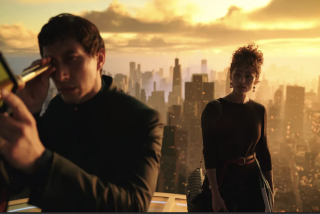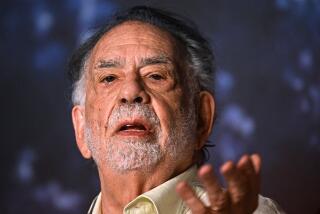For Her, Much Is a Matter of Upbringing
PARK CITY, Utah — With her pedigree and the controversy she attracted nearly a decade ago, you expect Sofia Coppola to be larger than life. But as she slides onto a sofa in a hotel at the Sundance Film Festival, she seems soft-spoken, waif-like, sleep-deprived. She hardly seems capable of ordering room service, let alone directing a movie. But now, after careers as an actress, photographer, clothing designer and--though this is hardly a career, and it is certainly not something she sought--the 28-year-old daughter of one of America’s greatest filmmakers, she has done just that, with “The Virgin Suicides” (opening Friday).
“I felt like I knew what I was doing,” she says simply, when asked if she was nervous (she had reason to be). “I was afraid that I would freeze up and not know what to do, but as soon as I was there and there was so much to do, you’re already making decisions all the time, so . . .” she quickly got on with the job.
“The Virgin Suicides,” which Coppola adapted from Jeffrey Eugenides’ novel, is about five mysterious Lisbon sisters and the boys who loved them. It’s set in 1970s suburbia and steeped in adolescent longings, confusions, anxieties. The cast is a mix of pros (James Woods and Kathleen Turner as the out-of-it Lisbon parents), semipros (Kirsten Dunst as the glittery Lux Lisbon; Josh Hartnett as Trip, the BMOC) and nonpros (Leslie Hayman, A.J. Cook and Chelse Swain as the other Lisbon sisters).
The feel of the film--in which the characters are largely undifferentiated, the sets and costume design strive for a sort of pastel banality, and the soundtrack features a mix of the French electronic group Air and such slightly off-center ‘70s acts as ELO and Todd Rundgren--is both mythic and specific.
“I sat next to two guys in their 40s at a screening, industry people who’ve seen it all, and they were poking each other in the ribs, ‘Oh, God, remember that?’ ” says the film’s producer, Julie Costanzo. “I think part of it is specific to the era, but I think what Sofia did so well was [that] it speaks to everybody at all times, that painful period, 13 to 17.”
The question is, where does it all come from? Coppola was a child, not a teenager, during the ‘70s. More to the point, as the daughter of Francis Ford Coppola, she hardly had the conventional suburban upbringing so lovingly detailed in “The Virgin Suicides.” She was the baby christened during the violent climax to the first “Godfather.” She remembers playing in the Philippines, where her father made “Apocalypse Now,” (a legendarily chaotic production that was chronicled in the documentary “Hearts of Darkness: A Filmmaker’s Apocalypse” and in a published journal written by her mother, Eleanor, which Sofia still finds too painful to read).
She lost her 23-year-old brother, Gian Carlo, in a boating accident that occurred in Maryland during the filming of her father’s “Gardens of Stone” in 1986. She was educated at a variety of schools, both public and private, in such places as New York and Oklahoma, wherever Francis was shooting. Yet despite all of the drama and rootlessness, Coppola doesn’t seem particularly jaded or oblivious. Part of this she attributes to her mother.
“My mom is really down to earth,” she says. “She is not the typical Hollywood director’s wife.”
As difficult as it was as a child to adjust to all these different situations, “I liked going into these new worlds because you kind of had to learn how to fit in,” Coppola continues. “It was hard, but I also enjoyed it. In Napa, I did go to high school the whole time. I graduated with people I went to first grade with. I was probably more precocious than most. I wasn’t the oddball.”
Apparently the suburban teenage life she’s seen, if not exactly lived, is something that obsesses her. It provides her with a readily accessible framework to tell “an honest, pure story,” as Costanzo puts it, adding, “If you think about it, that happens only in your youth, because everything after that becomes manipulated and premeditated.”
After attending CalArts in L.A. and then dabbling in various pursuits, including appearing in a short-lived TV show (“Hi-Octane”), Coppola returned to the family home in Napa Valley, Calif., to make what turned out to be a “Virgin Suicides” dry run, called “Lick the Star.” Financed by the Independent Film Channel, the short film was about a class queen who is dethroned after making a racist remark.
It was during this period that Coppola read and fell in love with “The Virgin Suicides.” She decided she wanted to adapt it, even though the rights to the property belonged to Muse Productions, which already had a contract with another director. Because of this Francis told his daughter that she was only setting herself up for heartbreak by pursuing the project. Nevertheless, she persisted. When she showed the finished product to Costanzo, the producer was so bowled over by it that she passed it along to Muse. Similarly impressed, Muse abandoned its previous commitment and entered into discussions with American Zoetrope, Francis’ production company, for Sofia to direct the movie.
Costanzo insists that Muse’s change of heart--and its willingness to go with a first-time director--was not contingent on Francis’ participation. For one thing, Sofia had demonstrated directing chops in “Lick the Star.” For another, there was the script. “Once you read it, you can’t see Francis in it anywhere,” Costanzo says.
This is not to say that Sofia didn’t avail herself of what her father had to offer, at least in terms of talent (and financing). Costanzo works at Zoetrope, and producer Fred Roos is a longtime Coppola collaborator.
Turner had starred in Francis’ “Peggy Sue Got Married.” To hear Sofia tell it, Woods came out of nowhere, unexpectedly responding to the script’s Ed Grimley-like dad, the opposite of the edgy, often hostile characters he normally plays.
It’s a measure of Coppola’s confidence that not only did she embrace high-octane actors like Turner and Woods but also kids who had never acted before. According to Costanzo, they scoured high schools and skateboard parks despite the fact “that everybody in Hollywood wanted her to hire the ‘Dawson’s Creek’ kids, kids who basically had acting chops and were established and had a presence already.”
Perhaps the biggest challenge Coppola faced with “The Virgin Suicides,” bigger than writing the script on spec or directing established talent or casting unknowns, was going up against the Coppola legacy, of which she is inextricably a part. Audiences won’t forget her roundly reviled acting debut in 1990’s “The Godfather Part III.” Some simply may not be able to get around who she is--although, ironically, who she is may help attract an audience for the movie.
“I would love for this to be my first film and get the same chance as someone else, but it’s just not part of my reality,” she says evenly. “People ask me, ‘Did your dad help you? Did he direct it for you?’ ”
“Once you walk into the film that completely vanishes,” Costanzo insists. “You’re seeing something on such a personal level that’s really very thoughtful and profound. And it belongs to no one but her.”
When it’s suggested that she could change her name, perhaps take the name of her husband, Spike Jonze (director of “Being John Malkovich”), Coppola laughs and says, “Yeah, but that’s not his real name either [it’s Adam Spiegel, of the famed catalog family]. I’m not going to hide where I’m from.”
More to Read
Only good movies
Get the Indie Focus newsletter, Mark Olsen's weekly guide to the world of cinema.
You may occasionally receive promotional content from the Los Angeles Times.









